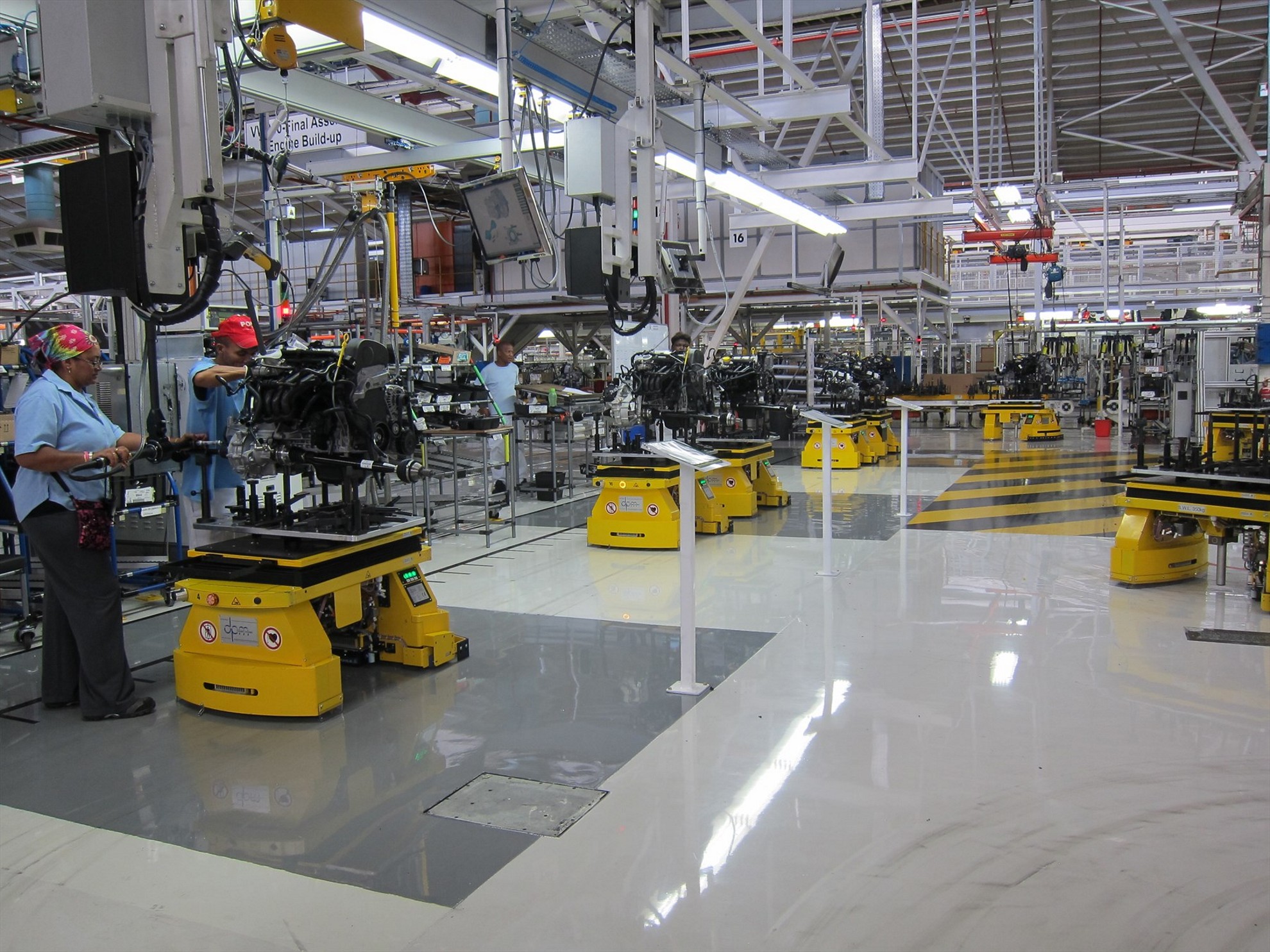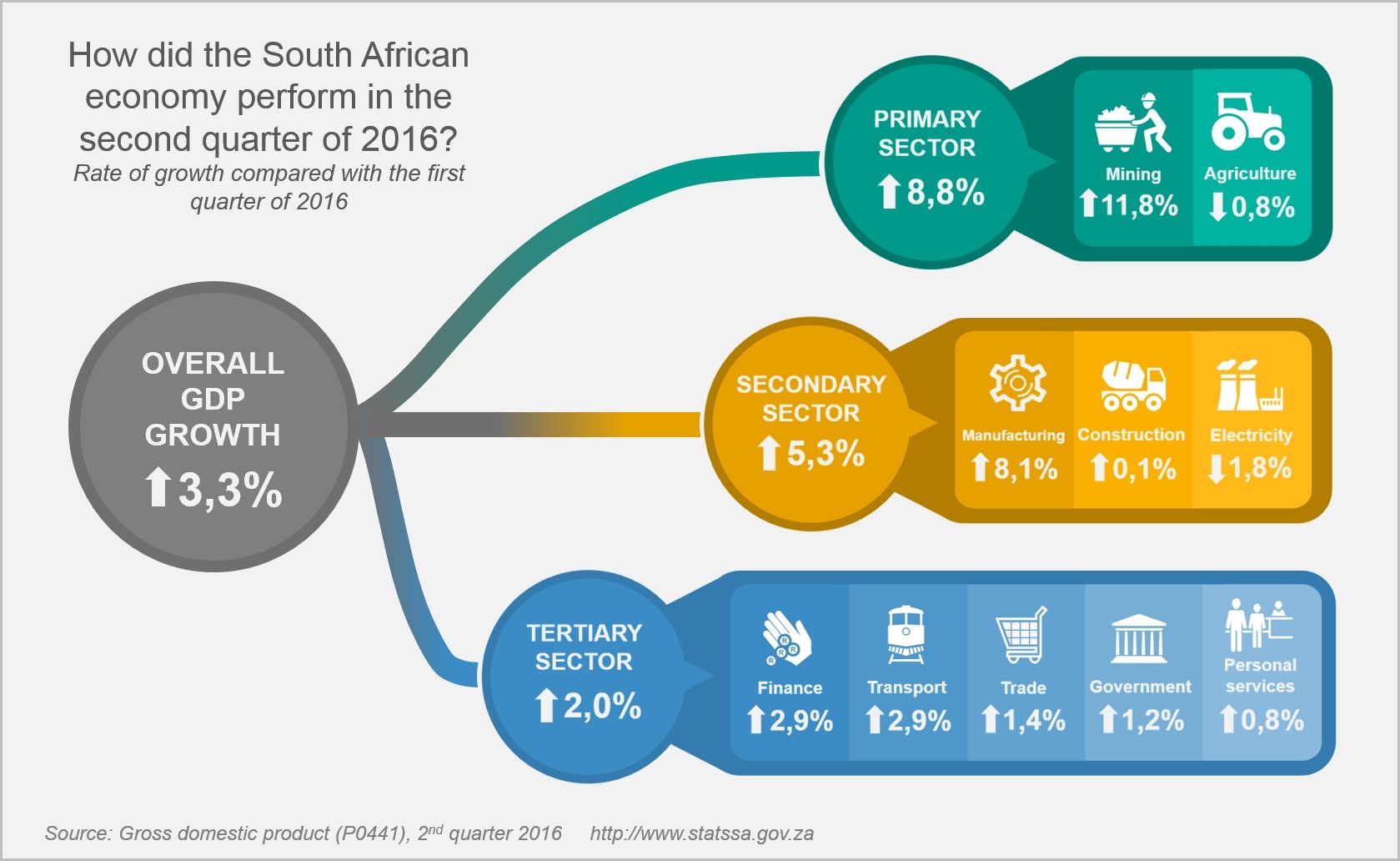Economia
Business News
MANUFACTURING INDUSTRY 2014 REPORT
Statistics South Africa (Stats SA) today released the Manufacturing industry, 2014 report which indicates that the total income for the manufacturing industry has increased by 9,4% per annum, from R1,68 trillion in 2011 to R2,20 trillion in 2014. Comparing 2011 and 2014, large increases were reported for ‘coke, petroleum, chemical products, rubber and plastic’ (+R248,1 billion), ‘food products and beverages’ (+R88,6 billion) and ‘transport equipment’ (+R81,3 billion). The contribution of the top 100 enterprises (CR100) has risen from 53,5% in 2005 to 58,1% in 2014.
The report further indicates that employment has declined from a high of 1 436 000 in 2005 to a low of 1 190 000 in 2014 (a loss of 246 000 jobs). The biggest loss in employment was in ‘textiles, clothing, leather and footwear’ (-91 000), ‘food products and beverages’ (-52 000), ‘metals, metal products, machinery and equipment’ (-35 000), ‘furniture, other manufacturing and recycling’ (-32 000) and ‘transport equipment’ (-30 000). Jobs were only gained in ‘coke, petroleum, chemical products, rubber and plastic’ (+20 000).
Also, large enterprises contributed only 46,4% of employment whereas the small, medium and micro enterprises (SMMEs) created 53,6% of employment.
The districts with the largest income from sales of goods and services were ‘Cape Town’ with R366,2 billion (or 17,3% of the industry total), ‘Johannesburg’ (R342,0 billion or 16,2%), ‘Ekurhuleni’ (R268,8 billion or 12,7%), ‘eThekwini’ (R228,7 billion or 10,8%), ‘Tshwane’ (R145,7 billion or 6,9%), ‘Gert Sibande’ (R135,9 billion or 6,4%) and ‘Nelson Mandela Bay’ (R111,3 billion or 5,3%).
However, ‘Johannesburg’ had the highest employment (312 000 or 26,1%), followed by ‘Cape Town’ (157 000 or 13,2%), ‘eThekwini’ (156 000 or 13,1%), ‘Ekurhuleni’ (115 000 or 9,7%), ‘Nelson Mandela Bay’ (61 000 or 5,2%) and ‘Cape Winelands’ (51 000 or 4,3%).
Note to editors:
The manufacturing industry large sample survey is a periodic survey conducted every three to five years covering business enterprises registered for tax in South Africa. Results of the survey are used within Stats SA for benchmarking national accounts (e.g. the gross domestic product (GDP)), compiling supply-use tables. These statistics are also used by the private sector in analyses of comparative business and industry performance.
Since 1996, the survey was previously conducted for the reference years 2001, 2005, 2008, 2011 and 2014
Technical enquiries: Mr Joe de Beer Tel: (012) 310 8024
Cell: 082 888 2600
Email: Este endereço de email está protegido contra piratas. Necessita ativar o JavaScript para o visualizar.
Media enquiries: Ms Lesedi Dibakwane Tel: (012) 310 8578
Cell: 082 805 7088
Email: Este endereço de email está protegido contra piratas. Necessita ativar o JavaScript para o visualizar.
The full statistical release is available on the Statistics South Africa website: www.statssa.gov.za
Issued by GCIS on behalf of the Statistics South Africa
26 September 2016


Positive GDP growth in the second quarter of 2016
South Africa’s economy grew by 3,3% quarter-on-quarter (seasonally adjusted and annualised), according to estimates of real gross domestic product (measured by production). This is the fastest quarter-on-quarter rise in economic activity since the fourth quarter of 2014. Year-on-year growth in the second quarter of 2016 was 0,6%.
The mining and manufacturing industries contributed over half of the 3,3% rise. After contracting by 18,1% in the first quarter of 2016, the mining industry recovered strongly in the second quarter, rising by 11,8%. This was mainly due to increased production in platinum group metals (PGMs).
A rise in the production of motor vehicles helped manufacturing expand by 8,1%, the highest expansion since the fourth quarter of 2013. This is corroborated by data from the expenditure side of the economy, showing a substantial rise in exports of passenger and goods-carrying vehicles.
The agriculture industry continued its sickly run in recession territory, posting its sixth consecutive quarter of economic decline. The real value of the agriculture industry has fallen from R77,8 billion in the fourth quarter of 2014 to R66,7 billion in the second quarter of 20162.
Electricity, gas and water supply was the second industry to contract in the second quarter, falling by 1,8%. Electricity distribution in South Africa has been subdued, contributing to the industry’s contraction. The amount of electricity distributed was 2,0% lower in the first seven months of 2016 compared with the first seven months of 2015, according to Stats SA’s latest Electricity generated and available for distribution release.
Other quick facts from the latest GDP release:
•Real GDP increased by 0,3% in the first six months of 2016 compared with the first six months of 2015
•Nominal GDP (measured by production) was estimated at R1 068 billion.
•Expenditure on real GDP increased by 3,4% quarter-on-quarter.
•Exports of goods and services increased by 18,1% quarter-on-quarter.
•Household final consumption expenditure increased by 1,0% quarter-on-quarter.
•Government consumption expenditure increased by 1,3% quarter-on-quarter.
•Gross fixed capital formation decreased by 4,6% quarter-on-quarter.
•Imports of goods and services decreased by 5,1% quarter-on-quarter.


Source: Statistics South Africa, www.statssa.gov.za/
SA: Cabinet pleased with strategy to grow economy
Cabinet has taken note of the report back by the Minister of Finance to the President on the progress of government’s consultations with the private sector and labour on the economy. The President tasked Minister Pravin Gordhan to lead engagements with these social partners to map out a strategy and come up with measures for growing the economy and preserving the country’s credit rating. “Cabinet is pleased that this work has culminated in concrete initiatives that will improve the country’s economic prospects,” said Acting Minister in The Presidency or Planning, Monitoring and Evaluation, Nosiviwe Mapisa-Nqakula. She was addressing médium during a post Cabinet briefing on Thursday in Cape Town. The President announced several priority initiatives on Monday, which include: •a joint private and public sector fund for small business support; •addressing constraints to increasing investment in order to accelerate inclusive growth; •government and private sector co-investment in infrastructure, drawing on the experience of the successful Independent Power Producer Programme, and strengthening State-owned enterprises to ensure their financial sustainability and reinforcing their role in driving development.
http://africanbrains.net/2016/05/16/sacabinet-pleased-strategy-grow-economy/
Measures in place to ensure economy's resilience
President Jacob Zuma says measures have been put in place to ensure the economy’s resilience is sustained, as the world economy continues to experience sluggish growth. South Africa, like all other developing nations, could not emerge unscathed from the turbulent global economic conditions following the 2008 economic crisis. “I appointed an Inter-Ministerial Committee in January this year to further support and assist investors to leverage existing trade and investment opportunities in our country. In the recent past, I dispatched a team of South Africans led by the Minister of Finance to interface with investors abroad. “These efforts, among others, have started yielding positive results,” said the President. He said Government has worked hard to ensure the energy constraints the country experienced last year are addressed.
http://www.sanews.gov.za/business/measures-place-ensure-economys-resilience
GOVERNMENT LINKS
- The Presidency
- SA Constitution
- South African Government
- Department of International Relations and Cooperation (DIRCO)
- Websites of SA Missions Abroad
- Consular Information
- Government Communication and Information System (GCIS)
- Department of Trade & Industry (DTI)
- The South African Revenue Service (SARS)
EDUCATION AND RESEARCH LINKS
BUSINESS LINKS
- Portuguese-South African Chamber of Commerce and Industry (CCILSA)
- North West Development Corporation (NWDC)
- Trade & Investment Kwa-Zulu Natal (TIK)
- Trade & Investment Limpopo (TIL)
- Eastern Cape Development Corporation (ECDC)
- Western Cape Investment and Trade Promotion Agency (WESGRO)
- Gauteng Growth and Development Agency (GGDA)
- Mpumalanga Economic Growth Agency (Mii)
- Free State Investment Promotion Agency (FIPA)


